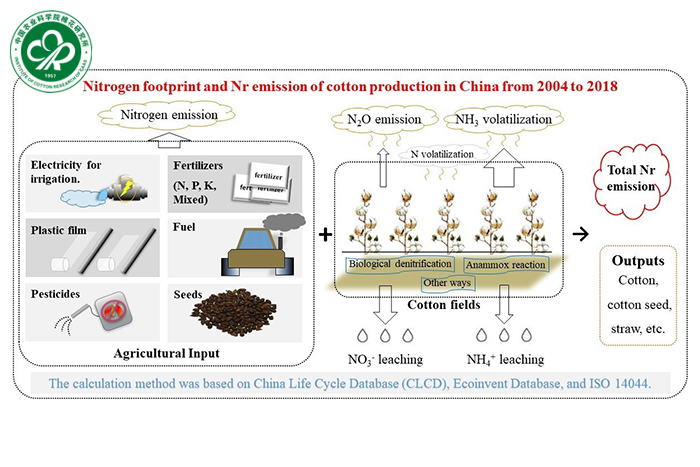- Location : Home» Newsroom
The research team led by Dr. Li Yabing from the CAAS has elucidated the spatiotemporal evolution and emission reduction potential of China's cotton production nitrogen footprint
Recently, a research team led by Dr. Li Yabing from the CAAS conducted a study on the nitrogen footprint of cotton production in China. This research quantified the nitrogen footprint of cotton production in China from 2004 to 2018. The study found that the nitrogen footprint of cotton production in China exhibited a trend of "higher in the south and lower in the north, increasing year by year." It also identified significant potential for reducing reactive nitrogen emissions in cotton production. This research provides theoretical support for accounting for nitrogen emissions from cotton and for in-depth analysis of emission reduction potential, which can inform the development of policies and technological advancements for the green development of the cotton industry in China. The results of this study were published in the prestigious international academic journal "Journal of Cleaner Production" under the title "The nitrogen footprint and reactive nitrogen reduction potential of cotton production in China" (IF=11.1, Environmental Science Q1).
Agricultural activities are a major source of anthropogenic reactive nitrogen emissions, and in a populous country like China, excessive fertilizer use and low utilization efficiency exacerbate nitrogen emissions, leading to severe environmental problems. Achieving agricultural sustainability becomes imperative under the immense pressures of population and the environment.
Cotton is a vital economic crop, a raw material for the textile industry, and a strategic resource in China. Quantifying the nitrogen footprint of cotton production in China, analyzing its spatial and temporal variations, and assessing its potential for reducing reactive nitrogen emissions are of great significance for achieving green and sustainable cotton production in the context of China's "ecological civilization construction." The study found that from 2004 to 2018, the nitrogen footprint per unit area of cotton production in the inland cotton regions of northwest China continued to increase, while the nitrogen footprint in the Yellow River basin cotton regions and the middle and lower reaches of the Yangtze River cotton regions decreased. Nitrogen fertilizer and its associated nitrogen losses were identified as the primary sources of reactive nitrogen emissions. Model predictions indicated that, compared to 2018, under optimal scenarios involving nitrogen reduction and efficiency improvement, as well as effective policy interventions, China's cotton production could reduce nitrogen emissions by 54.43 kilotons by 2050. The research results offer new insights into reducing nitrogen emissions in cotton production in China and optimizing nitrogen management in cotton cultivation.
This research received support from the National Key R&D Program (2020YFD1001000) and the National Natural Science Foundation of China (31701389). Master's students Huang Weibin and Wu Fengqi from the College of Agriculture at Zhengzhou University, along with doctoral student Zhang Zhenggui from the CAAS, are the first authors of the paper. The corresponding authors are Researcher Wang Guoping, Researcher Li Yabing, and Researcher Wang Zhanbiao from the CAAS. The State Key Laboratory of Cotton Biology, located at Zhengzhou University, is the first completion unit of this research.
Original article link: https://doi.org/10.1016/j.jclepro.2023.136808
